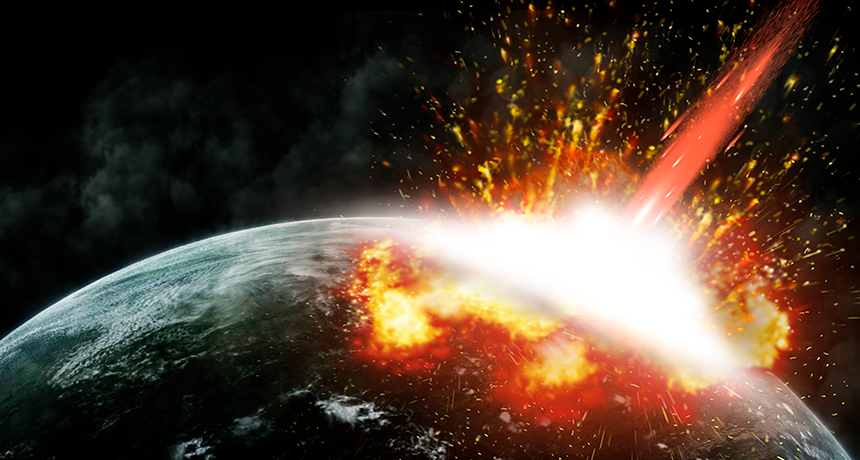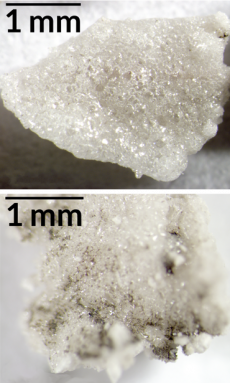Asteroids may have delivered water to early Earth
Much of the space rocks’ water would not have boiled away on impact

An asteroid impact can create glass and melted rock, which can trap water vapor. The finding boosts the idea that asteroids brought water to the early Earth.
Zloyel/iStockphoto
Shooting small rocks from a high-speed cannon sounds like a school science project. In fact, it was a sophisticated science experiment. And the results showed how some asteroids could have brought water to the early Earth.
“We can’t bring an asteroid to Earth and crash it into the Earth. Bad things would happen,” says R. Terik Daly. “So we went into the lab and tried to recreate the event as best we can.” Daly is a planetary geologist at Johns Hopkins University in Baltimore, Md.
The solar system formed about 4.6 billion years ago. Earth developed fairly close to the sun. Here, it would have been too hot for water to condense out of its gas phase and form liquid water. Earth also was too small to hold onto much nearby gas anyway. So scientists think the pale blue dot may have received its water from elsewhere. How that might have happened, however, remains an open question.
Daly wanted to test whether Earth could have gotten its water from asteroids. His team’s new data indicate asteroids could have delivered up to 30 percent of their stored water to growing planets.
The group shared its findings April 25 in Science Advances.
How they learned that
Daly’s got his PhD in Earth and planetary sciences, last year, at Brown University in Providence, R.I. While there, he worked with planetary scientist Peter Schultz. Together, the two made marble-sized pellets of antigorite (An-TIG-or-ite). It resembles the type of rock that may have brought water to Earth billions of years ago.
To simulate a dry planetary surface, the team used a type of volcanic rock called pumice (PUMM-is). They baked it at 850° Celsius (1,562° Fahrenheit) for 90 minutes. Then they shot the antigorite pellets at this baked rock at the NASA Ames Vertical Gun Range in California. The pellets flew at about 5 kilometers (3.1 miles) per second. That speed is similar to that at which asteroids probably crashed into each other and nearby planets during the solar system’s early days, Daly says.
Computer programs have modeled what such impacts must have looked like. These computer models suggested that if an asteroid had been traveling faster than 3.1 kilometers per second, all of its water would vaporize upon impact. Early Earth lacked an atmosphere. So there, the water vapor should have been lost to space.

But the experiments by Daly and Schultz showed something different. Some water vapor released by the pellets’ impacts was captured within glass that was created from shocked rock. Water vapor also captured in conglomerates of “busted-up” rocks. These are called breccias (BREH-chee-uhs).
The next step, Daly says, will be working out how the water could escape from such rocks to create oceans and other bodies of water.
“I really like this work,” says Yang Liu. She is a planetary scientist at NASA’s Jet Propulsion Laboratory in Pasadena, Calif., and was not involved in the study. “The experimental setup,” she observes, “is very clever.”
Liu studies water in material from the moon. One frequent question about her work is how the moon could have water at all. It lacks a thick atmosphere where vapor can accumulate. That means the moon should have had an even harder time than Earth did holding onto any impact-delivered water.
“This work demonstrates that this is feasible even for airless bodies” such as the moon, she says. The finding even suggests a way that future crewed missions might find water on the moon. To get the water we need, she says, perhaps researchers should look for rocks that melted when a meteorite hit them.
Daly’s interest in science didn’t start in college. He has been interested in it since he was a boy. In high school, he even took part in in two major science competitions. One was the Intel International Science and Engineering Fair. The other was the prestigious Science Talent Search (now sponsored by Regeneron). Both competitions are programs of the Society for Science & the Public (which also publishes this magazine).







